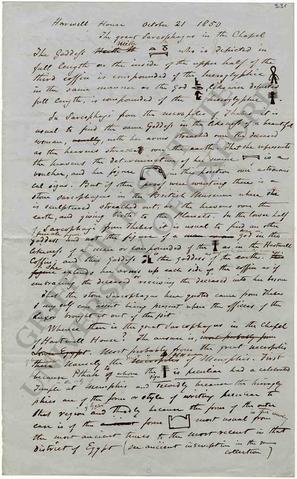
Identity area
Reference code
Bonomi MSS 3.3 (recto)
Nadpis
Date(s)
- 21 October 1850 (Creation)
Level of description
Item
Extent and medium
1 item
Context area
Name of creator
Archival history
Immediate source of acquisition or transfer
Content and structure area
Scope and content
Notes on the wooden sarcophagus and two coffins of Ir, Dyn. XXVI, from Thebes, formerly in H. Salt, J. Lee and Lord Amherst collections and at Sotheby's in 1921, current location not known (TopBib i2.835):
- ink text on paper
- loose
- 20.6 x 33.2 cm
- [text]:
'Harwell House October 21 1850
The great Sarcophagus in the Chapel
The GoddessNeith NNeith [X1*W24:N1] who is depicted in
full length on the inside of the upper half of the
third coffin is compounded of the hieroglyphic [V39]
in the same manner as the god [Q1\:D4\:A40], likewise depicted
full length, is corresponded of the hieroglyphic [R11].In Sarcophagi from the necropolis of Thebes it is
usual to find the same Goddess in the likeness of a beautiful
woman,usually, with her arms streached over the deceased
as the heavens streachedover the earth. That she represents
the heavens the determinative of her name [N1] is a
voucher, and her figure [C199] in this position over astronomi
cal signs. But if other proof were wanting there is a
stone sarcophagus in the British Museum where she
is sculptured streached out, as the heavens over the
earth, and giving birth to the Planets. In the lower half
of Sarcophagi from Thebes it is usual to find an other
Goddess female figure and not the figure of aman or oneman or god in the
likeness of a man or compounded of the [R11] as in the Hartwell
Coffin; and this goddess [X1\:H8-Q1] is the goddess of the earth. as might be naturally suppose(?)ThisfigureShe extends her arms up each side of the coffin as if
embracing the deceased or receiving the deceased into her bosomThat the stone Sacrophagus here quoted came from Thebes
I my self can assert being present where the officers of the
Luxor brought it out of the pitWhence then is the great Sarcophagus in the Chapel
of Hartwell house? The answer is,most probably fromLower Egypt. Most probably from the great necropolis
of Lower Egypt there namely theNecropolisdesert of Sakkara of Memphis. First
because Pthahofto whom(underlined) the sign R11 is peculiar(underlined) had a celebrated
Temple at in the city of Memphis and secondly because the hierogly
phics are of the form or style of writing peculiar to
this region of Egypt and thirdly because the form of the outer
case is of theancientform [Q6] most usual from in this nearby(?)
the most ancient times to the most recent in that
district of Egypt (See ancient inscription in the same
collection)'
Appraisal, destruction and scheduling
Accruals
System of arrangement
Conditions of access and use area
Conditions governing access
Conditions governing reproduction
Copyright Griffith Institute, University of Oxford
Language of material
Script of material
Language and script notes
Physical characteristics and technical requirements
Finding aids
Allied materials area
Existence and location of originals
Existence and location of copies
Related units of description
Publication note
- See Bonomi, Joseph, Catalogue of the Egyptian antiquities in the museum of Hartwell House. [London]: W. M. Watts, 1858 (OEB 134902), p. 89-91 [no. 596].
Notes area
Alternative identifier(s)
Access points
Subject access points
Place access points
Name access points
Genre access points
Description control area
Description identifier
Institution identifier
Rules and/or conventions used
Status
Level of detail
Dates of creation revision deletion
Jazyk(y)
Script(s)
Zdroje
Digital object metadata
Filename
Bonomi_03_03_recto_res600ppi.jpg
Latitude
Longitude
Media type
Image
Mime-type
image/jpeg